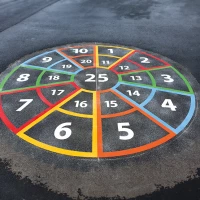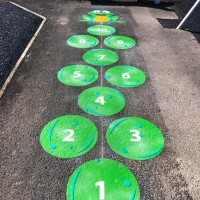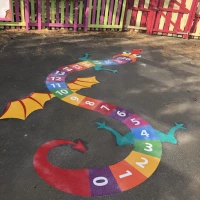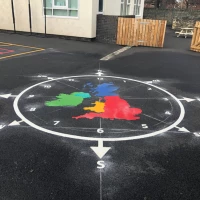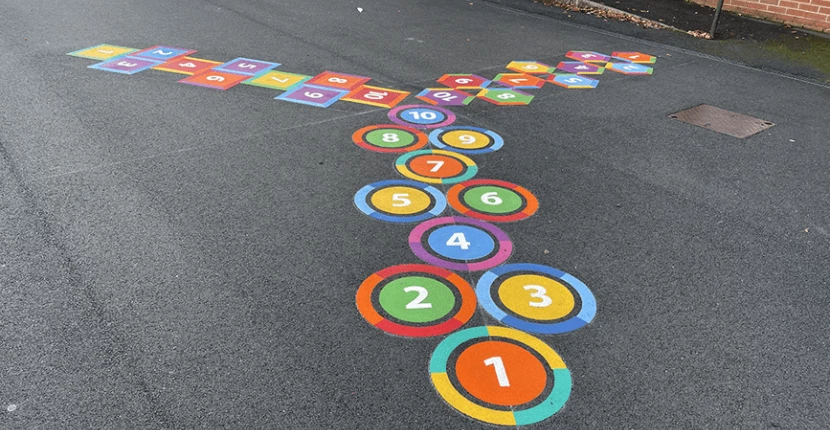
School Playground Markings
Get In TouchSchool Playground Markings specialises in transforming school playgrounds into vibrant, engaging spaces that inspire learning, play, and physical activity.
We offer high-quality thermoplastic markings tailored to your school's needs, including educational games, sports courts, and imaginative designs.
With a focus on durability, safety, and customisation, our solutions promote inclusivity, support physical education, and enhance student social interaction.
Contact us today for a free consultation and quote to revitalise your playground and create an outdoor environment that enriches learning and play.
What are School Playground Markings?
School playground markings are decorative and functional designs applied to outdoor surfaces using durable materials such as thermoplastic.
Thermoplastic markings transform plain playgrounds into interactive and engaging spaces, providing children with structured zones for play, physical activities, and learning.
Playground markings cater to various purposes, including traditional games, sports layouts, and educational themes. They improve the utilisation of outdoor areas across , fostering creativity, collaboration, and physical development.
Benefits of Thermoplastic Playground Markings
Thermoplastic playground markings provide a durable and vibrant solution for transforming outdoor spaces into engaging play, learning, and physical activity environments. Below are the key benefits of choosing thermoplastic markings:
Longevity: Thermoplastic markings are highly durable, lasting up to 10 years with minimal maintenance.
Weather Resistance: Resistant to fading, cracking, and wear from exposure to sunlight, rain, or frost.
Vibrant Colours: Retains bright, engaging colours that attract children and enhance the playground's appearance.
Eco-Friendly: Made from recyclable materials with low environmental impact during installation.
Non-Toxic and Safe: Designed using non-toxic, slip-resistant materials that meet child safety standards.
Customisation Options: Easily tailored to match school branding, themes, or educational goals.
Quick Installation: Applied using heat for a strong bond, allowing fast and efficient setup.
Cost-Effective: Long lifespan reduces the need for frequent replacements, saving money over time.
Low Maintenance: Requires minimal cleaning and repairs, ensuring ongoing usability with little effort.
Versatility: Suitable for various designs, including educational games, sports courts, and inclusive play areas.
Thermoplastic playground markings combine safety, sustainability, and creativity to maximise the value and impact of outdoor spaces.
How do Playground Markings Enhance Learning and Play?
Playground markings integrate physical activity with educational and social development.
Learning is enhanced by incorporating subjects such as maths, literacy, and geography into games like number grids, alphabet trails, and world maps.
Play is enriched by creating structured zones for classic games such as snakes and ladders or obstacle courses, allowing children to practise problem-solving, coordination, and teamwork.
This combination supports cognitive and physical development while reducing sedentary behaviours during breaks.
What Types of Playground Markings are Available for Schools?
Schools can choose from various playground markings to create versatile, engaging outdoor spaces that support play, learning, and physical activity.
These markings can be tailored to meet each school's educational goals, age groups, and specific needs. Below are the main types of playground markings available:
Educational Markings
Educational markings integrate academic concepts into outdoor play across .
Examples include alphabet trails, number grids, times tables, maps, and science-themed designs like solar systems. These markings enhance learning while encouraging physical activity.
Traditional Games
Classic playground games like hopscotch, snakes and ladders, and tic-tac-toe remain popular.
These markings offer timeless entertainment while promoting coordination, balance, and cognitive skills.
Sports Courts
Playground markings for sports include tennis courts, football pitches, basketball courts, netball courts, and multi-use game areas (MUGAs).
These encourage teamwork, skill-building, and physical fitness during lessons and free play.
Fitness Trails and Activity Zones
Fitness trails and activity circuits, such as jumping tracks or agility ladders, promote active play and physical education.
They challenge motor skills, endurance, and balance while keeping children engaged.
Imaginative and Themed Play
Imaginative markings include roadways, adventure trails, animal tracks, or space-themed designs.
These inspire creative role-play and storytelling, fostering social and cognitive development.
Inclusive Play Markings
Inclusive markings are designed to be accessible for children of all abilities.
Examples include wheelchair-friendly pathways, sensory trails, and universally engaging designs that promote social interaction and equity.
By combining these types of markings, schools can create a dynamic and inclusive playground that meets various educational and recreational goals.
How much do School Playground Markings Cost?
The average cost of school playground markings is £250 - £3,000.
The cost of thermoplastic playground markings for schools depends on factors such as the area's size, the design's complexity, and the material used (paint is cheaper, but thermoplastic offers better longevity).
Custom designs and installation in uneven or large spaces may increase the price. Obtaining multiple quotes from professional installers helps ensure the best value.
How are School Playground Markings Installed?
The installation process for playground markings includes:
Preparing the surface by cleaning and removing debris.
Aligning and positioning the thermoplastic designs on the surface.
Heating the markings with specialised equipment to bond them to the surface.
Pressing the markings to ensure adhesion and a smooth finish. Professional installation ensures accuracy, durability, and compliance with safety standards.
How Long do Playground Markings Last?
Playground markings typically last 4–10 years, depending on the material used, weather exposure, and maintenance.
Thermoplastic markings are more durable and can withstand frequent use and adverse weather conditions, retaining their colour and integrity longer than paint.
Regular cleaning, protecting the surface from damage, and addressing wear early can help extend their lifespan further.
Contact Us
Get in touch with School Playground Markings today to discuss your playground needs .
Whether you’re looking for vibrant designs, educational games, or custom layouts, our friendly team is here to help.
Frequently Asked Questions
What Materials are Used for Playground Markings?
Playground markingsare made from thermoplastic or paint. Thermoplastic is the most common material due to its durability, vibrant colours, and ability to withstand weather conditions.
It is applied using heat and bonds strongly to the surface. Paint is an alternative option but tends to wear out more quickly and requires regular touch-ups.
Both materials are safe for children, and thermoplastic is preferred for its low environmental impact and long-term performance.
Are Playground Markings Safe for Children?
Playground markings are safe for children when designed and installed using appropriate materials and methods.
Our thermoplastic markings comply with safety standards to ensure durability and usability in a school environment.
Can Playground Markings be Customised for Our School?
Playground markings can be fully customised to suit your school’s specific needs, branding, and educational goals.
Schools can select unique designs, colours, and themes to reflect their identity or curriculum focus. For example, custom markings might include school logos, bespoke educational games, or designs tailored to local history or culture.
Customisation also allows the integration of accessibility features, ensuring the playground is inclusive for children of all abilities.
By working closely with professional designers, schools can create personalised markings that maximise engagement and provide meaningful, long-lasting benefits for students.
Can Old Playground Markings be Removed or Replaced?
Old playground markings can be removed, relined, restored or replaced through professional methods that prepare the surface for new designs.
Removal techniques include pressure washing, chemical treatments, or mechanical grinding to clear worn-out or faded markings.
After removal, the surface is cleaned and prepped to ensure optimal adhesion of the new markings.
Replacements can include updated designs, improved materials like thermoplastic, or customised markings tailored to current educational and recreational goals.
This process ensures the playground remains functional, visually appealing, and aligned with the school’s needs.
How do Playground Markings Contribute to Inclusive Play?
Inclusive playground markings are designed to accommodate children of all abilities, ensuring everyone can participate in outdoor activities.
Examples include wheelchair-accessible paths, sensory trails with visual and tactile elements, or designs with universal appeal.
These markings foster social inclusion, helping children of different abilities interact and play together in a supportive environment.
What Maintenance is Required for Playground Markings?
Playground markings require minimal but regular maintenance to ensure they remain vibrant, functional, and safe over time.
Cleaning: Remove dirt, debris, and stains using mild detergents or water-based cleaning solutions. Regular cleaning helps maintain visibility and attractiveness.
Inspection: Conduct routine inspections to identify signs of wear, fading, or damage, especially in high-traffic areas.
Repairs: Address minor issues like peeling or cracking promptly to prevent further deterioration and maintain safety.
Repainting or Replacement: For painted markings, periodic touch-ups may be needed. Thermoplastic markings generally require replacement only after several years of wear.
Surface Protection: Ensure the playground surface remains smooth and intact to support the markings' longevity. Avoid activities that might cause excessive abrasion or damage.
Professional services can also provide detailed assessments and maintenance solutions, extending the lifespan and usability of playground markings.
How can We Fund School Playground Markings?
Funding school playground markings can be achieved through several strategies tailored to your school’s resources and community engagement:
Grants and Government Funding: Apply for educational or community development grants from local authorities, charities, or organisations like the National Lottery.
Fundraising Events: Organise school-wide activities such as fun runs, bake sales, or fairs to involve the community.
PTA Contributions: Collaborate with the Parent-Teacher Association to pool resources and organise fundraising initiatives.
Corporate Sponsorships: Partner with local businesses willing to sponsor the project in exchange for recognition or promotional opportunities.
Crowdfunding Campaigns: Use online platforms to gather donations from alumni, parents, and supporters.
School Budgets: Allocate funds from the existing school budget, prioritising the project based on its educational and recreational impact.
Combining these methods can help schools secure the necessary funding while fostering community involvement and support.
Can Playground Markings Improve Social Interaction Among Students?
Playground markings improve social interaction among students by creating structured and inclusive spaces that encourage group activities and collaborative play.
Designs such as team games, hopscotch, or sports courts promote teamwork, communication, and problem-solving skills. Imaginative markings, like roadways or themed trails, inspire cooperative role-play, helping children build friendships and social confidence.
Inclusive designs ensure children of all abilities can participate together, fostering a sense of community and belonging. By facilitating shared experiences, playground markings support the development of strong social bonds among students.
How do we Choose the Right Playground Markings for Our School?
Choosing playground markings requires assessing the school’s educational goals, space availability, and budget.
Schools should prioritise durable materials, inclusivity for diverse abilities, and alignment with physical education objectives.
Consultation with stakeholders ensures the selected markings address both academic and recreational needs.
Get in touch
Skip to
Gallery
